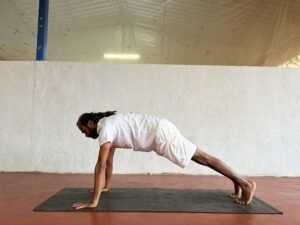What is Hatha Yoga?

What is it? Is it just Yoga? What is the difference?
I know the world of Yoga can be a confusing one if you are just entering this glorious world, but I will say that I am here to clear a few things up for you.
Basically, most yoga practised in the west is Hatha yoga. It can be translated as ‘disciplined force’ (ref: Britannica.com) and hatha is a practice of postures or poses (asanas) that relieve tension and stress from the body to enable a state of meditation and peace to occur.
So that is the ‘overview’ but how has something that is an ancient practice changed its look & purpose over the years.
A lot of Hatha has adapted for the needs of the western world – the drive for a leaner body, stress relief from work overstimulation have meant that a lot of the yoga has changed its look. It is sometimes derived as Power Yoga, where the focus is on strength & fitness.
This type of Yoga is still founded in the poses of Hatha Yoga but really focuses on the Asana side.
In fact so many styles of Yoga (Ashtanga, Iyengar, Vinyasa, Bikram) all take their foundations from Hatha Yoga.
Asana
Recognisable in their beauty, the main element of yoga that we are aware of are the body shapes/poses. The sanskrit word for these is Asana.
Pranayama
The deeper side of Hatha Yoga, incorporates Pranayama – breath work.
I cannot begin to adequately express the level of healing and transformation that the boy & mind go through just by using the breath! The breath has a huge effect on the vagus nerve and thereby the para sympathetic nervous system, immediately stimulating a calmness to the body & mind.
There are endless pranayama practices involved with Hatha Yoga, each one as valuable and profound as the next.
Manta
The chanting of mantra focuses the mind – basically ‘giving it something to do’. But aside from that most basic principle, the actual sound therapy within the body is the true magic.
Everything in the universe runs on frequencies. If you have experienced a Gong Bath, you will know what I mean. Each cell in the body vibrates continuously but at different levels of frequency. When using sound in a monotone vibrational way, the cells of the body vibrate.
This stimulates emotions to come up and healing to take place. The movement of the tongue within the mouth and touching the roof palette of the mouth access certain part of the brain and stimulates the hypothalamus.
Mudra
A mudra is a hand gesture. The positions of the hands and fingers has a more scientific purpose rather than just looking pretty. The body is a complete flow of energy and the polarities such as the feet and hands are the ends of particular circuits. How the hand/fingers are positioned or touching seals/closes or opens a circuit.
They also give the mind a point of reference. Once practiced enough, the simple act of touching your thumb to your forefinger will stimulate endorphins and the feel good chemicals.
Visualisation
During any kind of Hatha Yoga, be it asana, pranayama, mudra or mantra, visualisation will intensify your experience. The word Yoga means to ‘yoke’ or join, so the connection between mind, body & breath are all bought together with your clear visualisation.
When breathing, visualise silver light travelling up & down your sine with your breath.
When standing visualise roots connecting your feet to the earth, grounding you.
Your mind is your most powerful tool, so allow it to support and enhance your Hatha Yoga.
The Take Away
Hatha Yoga, may have changed some of it’s look over the years, but it still remains an ancient, proved to work practice that guides the Yogi to a place where by calm meditation can take place, if they so want to. Whether you want a power burst, a chant or a stretch, Hatha is still the tradition to provide you with all,
